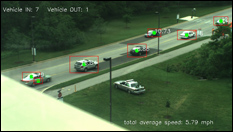$1 Million for Traffic Surveillance Research
Two Clark School professors have won a $1 million contract from the Federal Highway Administration. Professors Christopher Davis, electrical and computer engineering, and Stuart Milner, civil and environmental engineering, will collaborate on a three-year project using cooperating high-definition cameras to monitor traffic characteristics, such as vehicle speeds and types, incidents and congestion in the transportation infrastructure. Their research project, titled “Cooperating Camera Platforms for Ultra High Resolution Traffic Surveillance and Autonomous Event Detection,” is designed to provide much improved cooperating camera traffic surveillance. The use of cameras for this type of transportation infrastructure monitoring is proliferating at a phenomenal rate. However, the cameras are almost exclusively closed circuit television (CCTV) single cameras that may sometimes transmit live, streaming images over dedicated wired networks or the Internet, but most often, they require human monitors to detect incidents or control movement. The cameras currently used often have very low resolution or frame rates, and if they have any automatic detection capabilities, they are usually only capable of singular event detection such as stop-bar detection, counting vehicles, some type of classification, and possibly identifying accidents and vehicle speeds within a fixed area. These transmissions converge in operations centers where they rotate on multiple screens over time. In this mode, critical events can be missed if they are not viewed by an operator at the time they are displayed. Traffic surveillance systems almost universally use single CCTV cameras with low resolution and limited capability for analysis of real-time traffic movement patterns. This project aims to provide significantly improved cooperating high-definition camera traffic surveillance. The new system will have the capability to recognize “events” in the highway infrastructure and relay this information to command centers in real time. The technology also will enable and feature extraction algorithms to interoperate with ultrahigh resolution surveillance hardware. A number of unique technologies, like cooperating camera platforms, machine vision cameras, and servo-stabilized cameras, will effectively serve multiple purposes. The use of cooperating cameras enables significant improvements in computer vision algorithms and will allow for a test bed for developers of algorithms. If these systems are ultimately deployed they will make possible accurate real-time control of traffic flows to alternate routes, speedier dispatch of first responders to address highway problems, and in the future, possible tracking of vehicles from source to destination. Throughout this research and upon its conclusion, this project will expand industry understanding of the advantages of ultrahigh-resolution highway surveillance and real-time analysis and dissemination of detected “events” or anomalies.
Related Articles: October 24, 2012 Prev Next |


